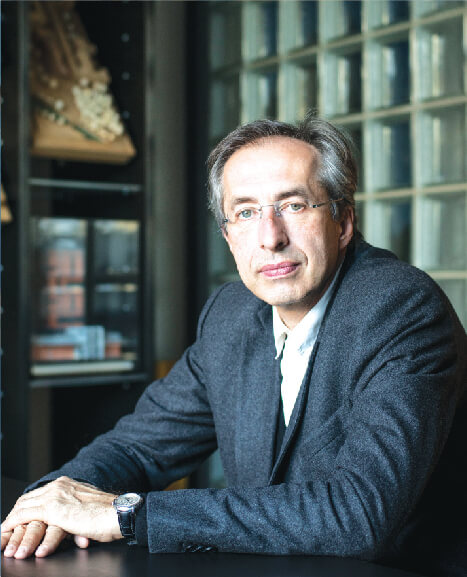
Sergei Tchoban
Question 1- How can architects, Planners and landscape designers intervene to alleviate the human afflictions in the realm of the built environment?
Architects and urban planners actually do not have the power or sufficient instruments in order to alleviate the human afflictions, even not in the realm of the built environment. They usually are not supposed to do it. Architects are rather suppliers of ideas, and their budget responsibility is limited to a very tight and predefined scope. But within the given frames they can make aware of certain conditions and offer single improvements in order to convince the decision makers.
I think it is very important for architects, and especially for professional beginners, to understand that most buildings belong to the ordinary urban surroundings and thus have to meet the needs of their inhabitants in the first place, including a humane and enjoyable appearance. In fact, the latter point is much more important than many of us think. We have to take into account that the bigger part of the buildings is just supposed to produce a particular common urban pattern which is interesting because of its little elaborate details. Outstanding buildings, on the other hand, do occur eventually, representing a kind of leader within a swarm and granting a point of clear identification.
Considering this approach, the design of the urban surroundings is able to contribute a lot to a better life.
Question 2- Please follow this idea:Between the countries from different civilizations in the different continents(Asia and Europe in this case) , there has been a constant history of trade, migration and sharing of cultural practices, which has extended strongly, even in the field of architecture. I realized these countries have a deep and true connection with moral principles, which has affected all aspects of its society (Culture, Architecture, Art and their identity in general), their root and identity has influenced their architecture. I also understood that their traditional architecture has been naturally developed in a sustainable manner, I believe that the underlying cultural, historical and spiritual values has led to creation of this form of natural sustainability.”
It is the differing uses of history, to create varied sets of architectural languages within our contemporary framework that is of interest. This is especially true in the context of globalization, which has a powerful tendency to homogenize.”- Hence, I would like to ask you as a member of the jury member of 2A Asia Architecture Award 2017, do you consider this thought when you design and practice?
Well, of course, the ideas of cultural exchange, free trade and free movement of individuals, which roughly make up globalization, do influence my work. And it is impossible to elude the impact of global powers. But still, having in mind that we are strongly involved in the current global tendencies, we can decide
how to act locally within the framework of a project.
Along with the growth of global exchange the architectural language has obviously changed. Outstanding forms, huge solitaires undeniably attract more professional and public interest than ordinary urban ensembles. And yet we should give our best, especially when designing everyday structures, in order to avoid endless clean glazed or concrete façades.
In addition to economic and ecological sustainability we have to create sustainable structures also on the level of a pleasant and worth appearance which can age in dignity. That’s why a lot of architectural offices return to using regional materials and traditional languages. We should focus more on making the surrounding value by working precisely with details. The relationship between the outstanding buildings and their surrounding should become more harmonious, even if it would be a harmony of contrasts.
Question 3- In order to understand the contemporary architectural and urban landscapes in different continents, in your opinion, what are the emergent manifestations of the world in contemporary Architecture and Urbanism?
Sustainability is one of the most important points in terms of structural standards, which means ecological, economical or social sustainability. The importance of certificates as DGNB or BREEAM proves that it is not enough to deliver only a spectacular form. The building has to be an all-rounder. Moreover, I think that a certain kind of modesty is highly valued. Look at this years’ RIBA Stirling Prize, the renovation of the Hastings peer. It is a very calm and pensive project,
revealing a love for details.
However for my part I’m missing a new profound theoretical basis. Without strong values we are forced to find always new approaches on the one hand and on the other the construction process is highly dictated by the building industry. As a result the cities become more and more similar.
Question 4 – How important is context in Contemporary Architectural Design? As a professional, researcher and educator working in Asia/Europe, what are factors, criteria or even constrains that have influential impact on your profession?
As I mentioned in my previous answers there are a lot of factors which influence my work. In fact you could divide them into two categories: hard and soft factors. While architects have to deal with a variety of hard factors as for example budget, clients’ wishes and legislation, they also have to consider a lot of soft criteria.
A particular surrounding (depending on the city and country you design and build), certain building traditions or the atmosphere of the place are such soft criteria. All this let the architecture turn into a long and complicated process of coordination and discussions.
